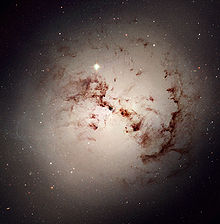Fornax cluster of galaxies
The Fornax galaxy cluster is a large collection of galaxies that is distributed over an area with an angular diameter of about 5 ° in the constellation Chemical Furnace (Fornax) . It can be found in the catalog of George Ogden Abell under the designation Abell S0373 .
This galaxy cluster is at a distance of about 60 million light years (18.5 Mpc ) the second richest cluster within a distance of 100 million light years, only surpassed in size by the Virgo galaxy cluster, which is about three times the size . It contains about 50–60 brighter galaxies, three of which are among the largest galaxies in this part of the universe. The elliptical galaxy NGC 1399 is a cD galaxy with an extensive diffuse halo, as typically occurs in large galaxy clusters (e.g. in the Coma galaxy cluster ). The large barred spiral galaxy NGC 1365 can be seen as the prototype of this galaxy class and as such is the most prominent member of the cluster. The largest member of the Fornax Cluster is the giant lenticular galaxy NGC 1316 , which has an apparent magnitude of 8.4 mag and an angular diameter of 12 arc minutes. This galaxy is at a frequency of 1400 MHz, the fourth most powerful radio source in the sky and is therefore also known as Fornax A , respectively.
Distance determination
The Fornax galaxy cluster is of great importance for the cosmological determination of distance. Since it has a much smaller mass than the Virgo Cluster, which is about the same distance, its gravitational influence on our local group is much smaller. While the Virgo heap causes the local group to be attracted by its large mass ( Virgo infall ), the Fornax heap moves largely with the large-scale Hubble River . By determining the distance of the galaxies in the Fornax cluster directly, the Hubble constant can be determined from their redshift . Due to the relatively short distance of the heap, various direct methods of determining the distance are now available. With the globular cluster luminosity function (GCLF), the distance was determined in 1996 to be around 16.5 Mpc. In 1998, the Hubble Space Telescope also succeeded in determining the distance of the cluster through the single star resolution of variable stars of the Cepheid type. From these measurements, the value assumed today for the distance of the Fornax cluster of 18.5 Mpc results. The mean redshift of the cluster members corresponds to a center of gravity speed of about 1300 km / s, so that the Hubble constant determined from these measurements (after some corrections ) results in H 0 = 73 km / (s · Mpc).
See also
- Virgo superclusters - superstructure of the galaxy clusters in our neighborhood
Web links
- ESO : VLT Survey Telescope succeeds in capturing the Fornax galaxy cluster + map, photos and animations April 13, 2016
- ESO: Galactic Secrets Revealing + Photos and Animations October 25, 2017
- astronews.com: Astronomers discover multitude of mini-galaxies April 6, 2004
- astronews.com: View into the Fornax galaxy cluster April 13, 2016
Individual evidence
- ↑ NASA / IPAC Extragalactic Database . In: Results for Fornax Cluster . Retrieved October 11, 2007.
- ↑ a b Barry F. Madore et al .: A Cepheid distance to the Fornax cluster and the local expansion rate of the Universe . In: Nature . tape 395 , no. 6697 , September 3, 1998, pp. 47-50 , doi : 10.1038 / 25678 .
- ^ The Fornax and Eridanus Clusters . In: Overview of the Fornax heap . Retrieved October 11, 2007.
- ^ A b Michael Hilker: GCSs and dwarf galaxies in the Fornax Cluster . In: Michael Hilker Research . Retrieved November 13, 2017.
- ^ Sven Kohlen, Markus Kissler-Patig, Michael Hilker, Tom Richtler, L. Infante, H. Quintana: The distance of the Fornax Cluster based on Globular Cluster Luminosity Functions . In: Astrophysics . April 9, 1996, arxiv : astro-ph / 9604036 .


